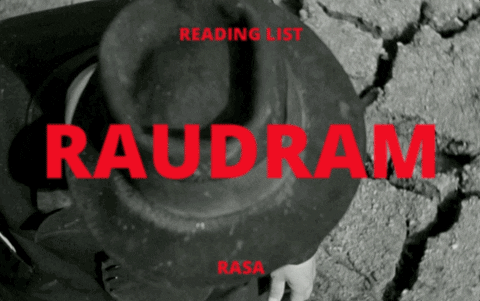-
Our monthly stories are productions looking to connect people to the magic of stories.
We create supplementary reading lists as a way to give you an insight into the inspirations and thinking behind our monthly stories. These reading lists take you behind the story, revealing the process of its making.
-

Rasa → Raudram (रौद्रं): Fury. Presiding deity: Shiva. Colour: red, Adbhutam (अद्भुतं): Wonder, amazement. Presiding deity: Brahma. Colour: yellow
-
Archetype → Creator
-
-
Carl Jung described the creative human best; “Who looks outside, dreams; who looks inside, awakes.” The defining superpower of the creator is to absorb the world and reproduce it new, made more interesting and beautiful inside their mind. We have all the art, music, books, films and objects thanks to minds that decided to play with this world. The creator can also make the world more tedious and render it a terrible place. This shadow aspect of the creator archetype is what we explored this month.
The mood we wanted to create in this story is that of raudra, or anger, identified in the eastern aesthetic theory of rasa. The anger in this story is latent but peripheral—at the intensity of frustration. We used the mood adbūtha, or wonder, as an undertone.
In this reading list, you’ll find stories, books, films, and events that reveal the shadow of the creator archetype, and raudra rasa evoking varying degrees of anger.
1976, death of Vladimir Komarov: Komarov died during the crash of the failed spacecraft Soyuz 1 which he was piloting solo. Soyuz 1 was launched on the orders of Leonid Brezhnev—leader of the Soviet Union, who wanted to stage a spectacular space rendezvous on the 50th anniversary of the Communist revolution—despite the spacecraft not being ready. Although Komarov and his close colleagues’ tried to postpone the operation, their concerns were not taken seriously. Komarov died screaming in rage and cursing the authorities as the spacecraft failed. Knowing that he was doomed with the faulty craft, Komarov requested an open-casket funeral before he boarded. Making the power-hungry leaders look at his remains charred from the impact of hitting the earth at meteoric speed was Komarov’s punishment to them. This recording of the last words from the transmission of Vladimir Komarov inside the crashing spacecraft brings on the raudra rasa in anyone who listens to it.
2006, The Yoga of the Nine Emotions: The Tantric Practice of Rasa Sadhana. Peter Marchand, Harish Johari. Destiny Books: This book details the raudra rasa from tantric and ayurvedic perspectives, delving into colours, tastes and foods linked to this rasa, emotional fasting exercises, and how it can be used for healing. Pages 78-88.
The shadow of the creator archetype is very much personified in the stereotype of the tortured artist: angered or anguished by the world, deep in self-doubt or with the toxic fuel of anxiety and pain feeding their creativity, this stereotype has probably grown beyond its truth and reached levels of myth. The two links below give an introduction to the stereotype and an analysis of its truth and myth.
2022 retrieved, Wikipedia: Tortured artist.
2019, The Art Assignment; the truth of the tortured artist.
1996, Touched With Fire. Kay Redfield Jamison. Simon and Schuster Publishers: This book written by a professor of psychiatry at the Johns Hopkins University School of Medicine reveals links between manic-depression and creativity, and encourages us to question the relationship that exists between art and madness. Based on studies and research on mood disorders, the book reveals the biological foundations of illnesses, lives and works of some of the world's greatest artists including Lord Byron, Vincent Van Gogh, and Virginia Woolf. As Lord Byron puts it, “We of the craft are all crazy. Some are affected by gaiety, others by melancholy, but all are more or less touched.”
When Carl Jung identified the creator archetype first, it was coined as ‘the artist’. We prefer to use the term ‘creator’ for this very same archetype as it includes the whole spectrum of creative minds that this idea applies to. This list includes excerpts from Carl Jung’s writing that touches on the archetype of the creator :
2022, Sri Lankan protestors retaliate against government-induced violence: On May 9th 2022, a mob consisting of the then Sri Lankan prime minister Mahinda Rajapaksa’s supporters attacked the peaceful, unarmed protestors on the public beach at Colombo’s Galle Face Greens. The protest, which has been a nationwide movement with its most popular site being at the Galle Face beach, is demanding the resignation of a regime accused of corruption, blatant nepotism and theft of public funds that has led to Sri Lanka’s worst economic crisis. Angered by this attack on civil rights and what was seen as the sacred ground of people’s power, Sri Lankans around the country started attacking vehicles and private properties of pro-Rajapaksa politicians. Many Sri Lankans supported the retaliations even as the violence escalated. Surrounded by angry protestors, Mahinda Rajapaksa was forced to resign from his role as prime minister that evening. May 9th violence in Sri Lanka is an example of collective fury, and where a majority of people enjoyed and encouraged and savoured the emotion of rage because they felt it was justifiable.
World in one news, WION
Primetime News, News First Sri Lanka
Unedited footage of May 9th violence, News First Sri Lanka
2018, A brief history of female rage in art. Ariela Gittlen, Artsy.net: This article talks about how, when justice seems elusive, images of angry women can be cathartic, even inspiring. It includes seven works from western art history that show the beauty and power of female rage.
